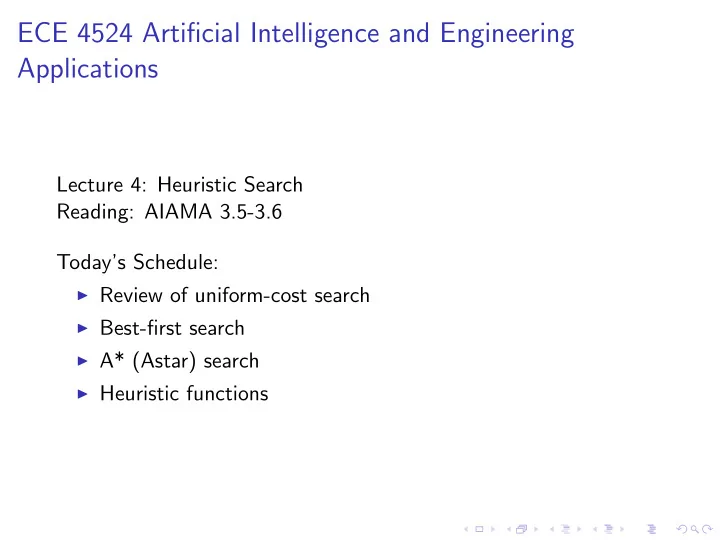

ECE 4524 Artificial Intelligence and Engineering Applications Lecture 4: Heuristic Search Reading: AIAMA 3.5-3.6 Today’s Schedule: ◮ Review of uniform-cost search ◮ Best-first search ◮ A* (Astar) search ◮ Heuristic functions
Warmup #1 Consider the following graph with initial node A and goal D. 1. What is the depth of the path A-B-D? 2. What is the path A-B-D cost? 3. Is the path optimal?
Uniform-Cost Search
Exercise: perform uniform-cost search
Informed search uses problem specific information to select which nodes to expand. ◮ Uniform-Cost search uses the path-cost, which we will denote g ( n ), to order nodes, n , in the frontier priority queue. ◮ Best-first search is the same as uniform-cost search, but with a general priority given by the evaluation function , f ( n ). The evaluation function is usually the sum of two terms f ( n ) = g ( n ) + h ( n ) where ◮ g ( n ) as before is the path cost for node n , the sum of the cost from the root to the node along its path (following parents back). ◮ h ( n ) is a heuristic function , which is an estimate of the path cost from n to the goal, and is problem-dependent . Note that h must be ◮ non-negative ◮ evaluate to zero at the goal, i.e. h (goal) = 0
Variations of Best-First Search Best-first search is uniform-cost search with priority f ( n ). When ◮ f ( n ) = g ( n ), this is uniform-cost ◮ f ( n ) = h ( n ), this is greedy (best-first) search ◮ f ( n ) = g ( n ) + h ( n ), this is A* (A-star) search
Warmup #2 Suppose the graph in Question 1 is augmented with the following heuristic function Node n h(n) A 5 B 1 C 2 D 0 In what order would nodes be goal-tested using greedy best-first search?
Exercise Node n h(n) A 5 B 1 C 2 D 0 What would be the contents of the frontier and explored set during A* search? Denote frontier entries as: (node label, parent, g, f)
Optimality of A* A* graph search is optimal if the heuristic, h ( n ), is 1. admissible, it never overestimates the distance to the goal, i.e. it is optimistic, and 2. consistent (monotonic), h ( n ) ≤ c ( n , a , n ′ ) + h ( n ′ ) Where ◮ n ′ is a successor of n generated by action a ◮ h ( n ) is the heuristic value at n ◮ h ( n ′ ) is the heuristic value at n ′ ◮ c ( n , a , n ′ ) is the step cost from n to n ′ via a
Some remarks about A* ◮ At any stage of the search the union of the frontier and explored set define an iso-contour of the state space that corresponds to the current maximum of f . ◮ The term prunning is used to denote that the effect of the heuristic is to prune from consideration portions of the state space that are unlikely to lead to a solution. ◮ A* works for inconsistent heuristics, but you have to update the priority of a node when expanded if it is already in the frontier. ◮ The heuristic h ∗ ( n ) is the (hypothetical) oracle and gives the exact minimal cost from n to the goal. ◮ A* is optimally efficient, no other algorithm (using the same information) expands fewer nodes in the search. ◮ The main limitation of A* is memory, unless you have very short time constraints.
Warmup #3 Consider the 8-puzzle problem with the following initial and goal nodes: and the number-of-tiles-out-of-place heuristic. What is the value of f for each child of the initial node in A* search?
Heuristic Functions So, to summarize, a heuristic function takes a node and returns a number that is ◮ an estimate of the cost to reach the goal from that node ◮ is always positive, unless ◮ is zero at the goal ◮ ideally is admissible (optimistic) and consistent ◮ the closer to the oracle h* the better
Exercise Consider the following graph with initial node A and goal F, with the step-costs and heuristic values indicated. Node n h(n) A 0 B 3 C 1 D 2 E 1 F 0 1. What are the contents of the frontier and explored set during A* search? 2. Is this heuristic admissible?
Next Actions ◮ Reading on Two-Player Games and min-max AIAMA 5.1 and 5.2 ◮ Take warmup before noon on Tuesday 1/30.
Recommend
More recommend